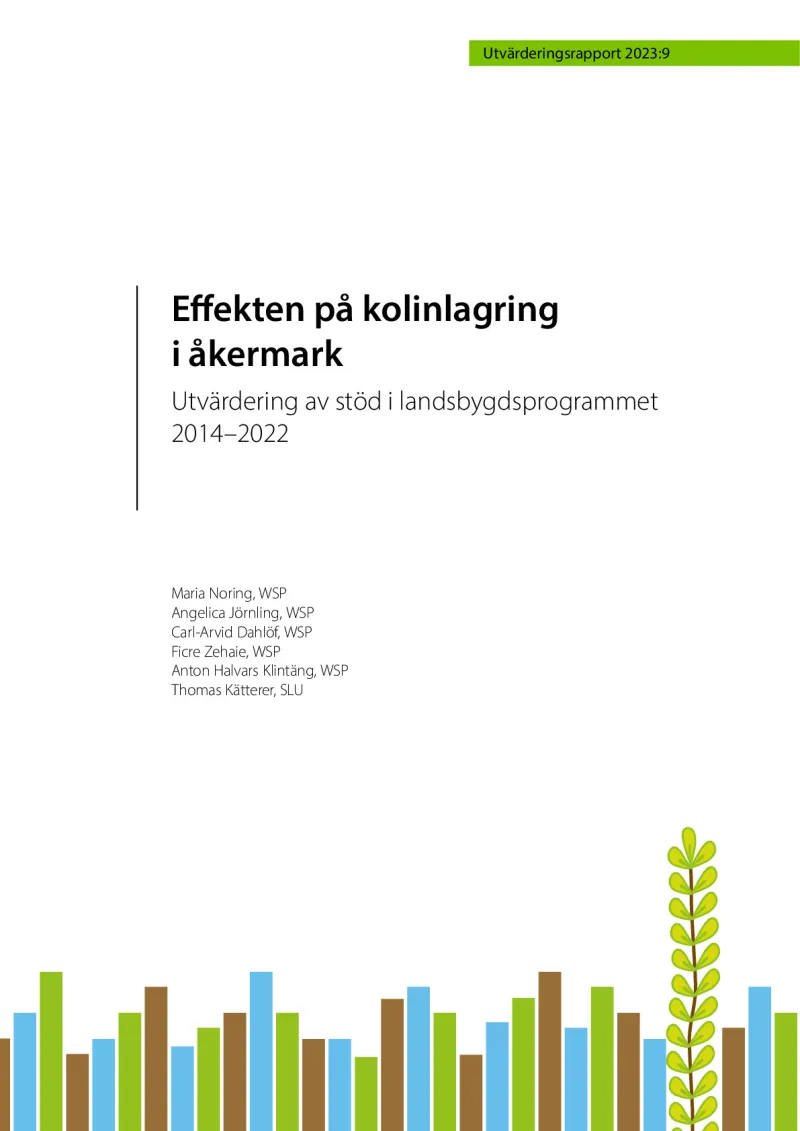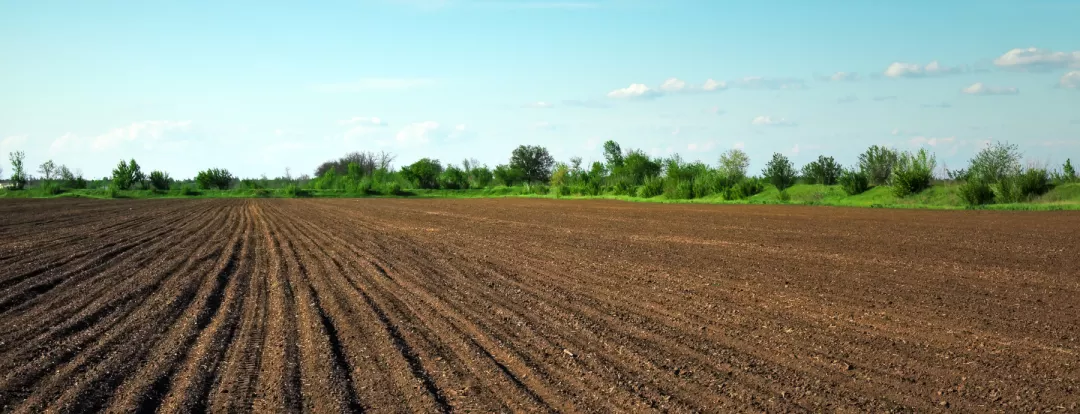Évaluation de l'effet sur le stockage du carbone dans les terres arables
L'évaluation porte sur l'impact du soutien accordé dans le cadre du Programmes de Développement Rural (PDR) 2014-2022 sur la quantité de charbon de terre dans les terres arables suédoises et analyse comment d'autres facteurs affectent la mise en œuvre des mesures dans le cadre du soutien.
- Sweden
- 2014-2022
- Environmental impacts


Le stockage du carbone dans le sol est l'une des mesures les plus rentables pour réduire le dioxyde de carbone dans l'atmosphère. L'agriculture dispose de plusieurs mesures de gestion qui contribuent au stockage du carbone dans les terres arables, dont certaines ont été soutenues par le PDR. Ce rapport présente une évaluation de l'impact sur le stockage du carbone dans les terres arables suédoises du soutien suivant dans le cadre du PDR 2014-2022 :
- compensation environnementale pour la réduction des fuites d'azote (culture et traitement de printemps) ;
- compensation environnementale pour la culture de l'herbe ;
- compensation environnementale pour la protection et les zones de protection adaptées ;
- compensation pour la conversion à la production biologique.
Le piégeage du carbone est l'une des mesures les plus rentables pour réduire le dioxyde de carbone dans l'atmosphère. L'agriculture dispose de plusieurs mesures de gestion qui contribuent au piégeage du carbone dans les terres arables, dont certaines ont été soutenues par le PDR. Ce rapport présente une évaluation de l'impact sur la séquestration du carbone dans les terres arables suédoises des mesures suivantes dans le cadre du PDR 2014-2022 :
- paiement agro-environnemental pour la réduction des fuites d'azote (cultures dérobées et travail du sol au printemps) ;
- paiement agro-environnemental pour la culture en sec ;
- paiement agroenvironnemental pour les bandes tampons et les zones tampons adaptées ;
- paiement pour la conversion à la production biologique ;
- paiement pour le maintien de la production biologique.
Les facteurs susceptibles d'influer sur la quantité de carbone du sol dans les terres arables suédoises sont notamment les effets des mesures, l'ampleur de l'aide, les niveaux de charbon du sol et les choix des agriculteurs.
L'analyse est basée sur quatre sous-questions, plus une sommative, chacune visant à créer des calculs et des estimations qui peuvent être utilisés pour y répondre. Les sous-questions suivantes ont été développées pour faciliter l'analyse :
- Quelles sont les mesures du PDR qui ont un impact sur le stock de carbone dans les terres arables et quel est l'impact de chaque mesure ? Quelles sont les autres mesures non incluses dans le PDR qui ont une incidence sur le stock de carbone du sol ?
- Dans quelle mesure les agriculteurs ont-ils demandé à bénéficier de l'aide ciblée et comment le champ d'application a-t-il varié dans le temps et géographiquement ?
- Le stock de carbone du sol des terres arables suédoises a-t-il évolué au cours de cette période ?
- Quels sont les autres facteurs qui ont une incidence sur la mise en œuvre des mesures et dans quelle mesure les mesures auraient-elles été mises en œuvre même sans le soutien du PDR ?
- Sur la base des sous-questions 1 à 4, quel effet les mesures ont-elles eu sur le stock de carbone du sol dans les terres arables ?
L'Office suédois de l'agriculture a identifié l'aide financière évaluée, qui est censée avoir un impact direct sur le stock de carbone dans les sols. En outre, l'évaluation identifie les possibilités d'amélioration des données de suivi des terres arables suédoises afin de faciliter les évaluations futures.
La réponse à la première sous-question est apportée par une analyse documentaire visant à compiler les mesures affectant le stock de carbone de la couche arable et l'effet des mesures sur le stockage du charbon (kg de carbone par hectare et par an).
La deuxième sous-question est traitée en utilisant les statistiques des bases de données de l'Office suédois de l'agriculture pour cartographier le changement, ainsi que les suivis et évaluations antérieurs de mesures spécifiques et du PDR.
Pour répondre à la troisième sous-question, la valeur du stockage total de carbone dans le sol (kg de carbone par an) dans les terres arables suédoises a été calculée sur la base des données et de la littérature existantes.
Pour répondre à la sous-question de savoir quelle proportion des mesures aurait été mise en œuvre même sans le soutien ou dans quelle proportion les mesures dépendent du soutien du PDR, des entretiens semi-directifs ont été menés, ainsi qu'une recherche documentaire d'orientation. Huit entretiens semi-directifs ont été menés (dont un auquel il a été répondu par courrier électronique), répartis entre quatre représentants de l'Office suédois de l'agriculture, trois coordinateurs d'action (dans le cadre du projet Leva) et un conseiller en culture végétale. Les coordinateurs d'action ont été choisis en fonction de leur connaissance et de leur expérience des incitations qui ont un impact sur la volonté des agriculteurs de mettre en œuvre des mesures d'amélioration de l'environnement. Un modèle de questions d'entretien a été utilisé et, sur la base des réponses des personnes interrogées, des questions de suivi approfondies leur ont été posées. La sélection des exploitants a été élaborée en collaboration avec l'Office suédois de l'agriculture.
Les résultats des différentes sous-questions ont été combinés pour calculer l'impact de l'aide sur le stock de carbone du sol dans les terres arables suédoises.
En ce qui concerne les limites, l'évaluation repose sur des études déjà publiées concernant les effets des mesures sur le piégeage du carbone dans le sol, sur les données existantes et sur le suivi de l'évolution des mesures. Outre la compilation des tendances, aucune analyse directe des données collectées dans le cadre des programmes de surveillance n'a été effectuée, et aucune nouvelle collecte de données sur le carbone du sol n'a été entreprise pour l'étude.
L'évaluation conclut que les cultures dérobées, la mise en place de bandes/zones tampons et de cultures en rotation ont un effet positif mais faible sur le piégeage du carbone dans les sols arables. Les exploitations d'élevage bovin et laitier affichent un stock de carbone nettement plus élevé que les exploitations agricoles et porcines, ce qui pourrait s'expliquer principalement par une production plus importante de fourrage.
En outre, le soutien du PDR est important pour la mise en œuvre de mesures visant à accroître le stockage du carbone. La superficie bénéficiant de l'aide est faible par rapport à l'ensemble des terres arables. Si l'on suppose que l'aide a une pleine additionnalité, elle pourrait contribuer à environ 20 % de la variation annuelle du stock de carbone dans le sol.
De nouveaux groupes d'agriculteurs ont demandé à bénéficier de l'aide et la superficie a augmenté. Il existe toutefois d'importantes variations entre les exploitations ayant un objectif similaire, et comme l'objectif et l'approche des agriculteurs ne sont pas indiqués dans les statistiques, il n'est pas non plus possible de calculer plus précisément l'effet de ces mesures sur le stock de carbone du sol.
Les mesures de gestion qui n'ont pas pu être soutenues ont également un impact positif. Toutefois, les mesures liées à l'agriculture biologique semblent avoir un impact négatif.
Author(s)
Maria Noring, Angelica Jörnling, Carl-Arvid Dahlöf, Ficre Zehaie, Anton Halvars Klintäng, (WSP) Thomas Kätterer, (Swedish University of Agricultural Sciences)